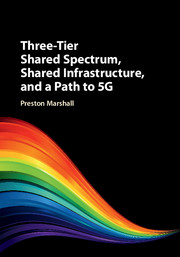Book contents
- Frontmatter
- Contents
- Acknowledgments
- Preface
- Part I Spectrum Sharing Background
- Part II Three-Tier Dynamic Spectrum Models
- Part III Components of a Three-Tier Architecture
- Part IV Protection Processes for Incumbents and Peers
- 8 General Process for Database System Operation
- 9 Protection of Incumbent Satellite Operations
- 10 Protection to and From Terrestrial Access Points and Point-to-Point Networks
- 11 Protection to and From Radar Systems
- 12 Coexistence Between Unprotected Peer Devices
- Part V Example Use of Three-Tier Spectrum: Use of the 3.5 GHz CBRS Band in the USA
- Part VI Future Bands, Network Services, Business Models, and Technology
- Part VII Appendices
- Index
- References
8 - General Process for Database System Operation
from Part IV - Protection Processes for Incumbents and Peers
Published online by Cambridge University Press: 30 August 2017
- Frontmatter
- Contents
- Acknowledgments
- Preface
- Part I Spectrum Sharing Background
- Part II Three-Tier Dynamic Spectrum Models
- Part III Components of a Three-Tier Architecture
- Part IV Protection Processes for Incumbents and Peers
- 8 General Process for Database System Operation
- 9 Protection of Incumbent Satellite Operations
- 10 Protection to and From Terrestrial Access Points and Point-to-Point Networks
- 11 Protection to and From Radar Systems
- 12 Coexistence Between Unprotected Peer Devices
- Part V Example Use of Three-Tier Spectrum: Use of the 3.5 GHz CBRS Band in the USA
- Part VI Future Bands, Network Services, Business Models, and Technology
- Part VII Appendices
- Index
- References
Summary
Introduction
This chapter will describe how the tools and models discussed in the last chapters are collected and organized to develop a comprehensive admission control process for three-tier spectrum bands, such as a Spectrum Access System (SAS). This will include an inventory of the models needed to construct an admission control system, and a high level description of the stateful information needed to perform the functions that are required to support the spectrum management regime. By necessity and for clarity, there will be some overlap with the discussion of methods in prior chapters.
The concept of the admission control system is a simple transaction processing system with a persistent state. The main transactions processed by the admission control system are described in more detail in other chapters. In this chapter, we will examine the fundamental functions of any admission control system that supports three-tier spectrum, and make this discussion as independent of the specific regime as possible. Also, we will abstract the complex algorithms that are the heart of the admission control system processing and only consider their functionality, not their internal design or level of implementation.
Later in this book (Chapter 13), the specifics of the admission control system for the US implementation of the Citizens Broadband Radio Service (CBRS) SAS and rules will be developed in detail, on a message by message, and object by object basis. This design is only one possible implementation of the fundamental interaction needs that are developed in this chapter.
Major Admission Control System and Device Transactions
The transactions that are described in this chapter generally mirror those that will be described in greater detail in Chapter 13. The functional grouping of the admission control system device transactions capabilities are:
Inquiry Provide device with information regarding spectrum environment, but make no changes to spectrum usage.
Grant Request Request a spectrum grant, and make any necessary adjustments to peer or lower-tier users.
Authorization Provide continued authorization to utilize a spectrum grant for a fixed duration of time.
Relinquish Relinquish a spectrum grant, and adjust the aggregate interference to reflect this removal of a node.
Reclaim A higher-tier user declares right to spectrum, or is detected, and that right is invoked.
- Type
- Chapter
- Information
- Publisher: Cambridge University PressPrint publication year: 2017



